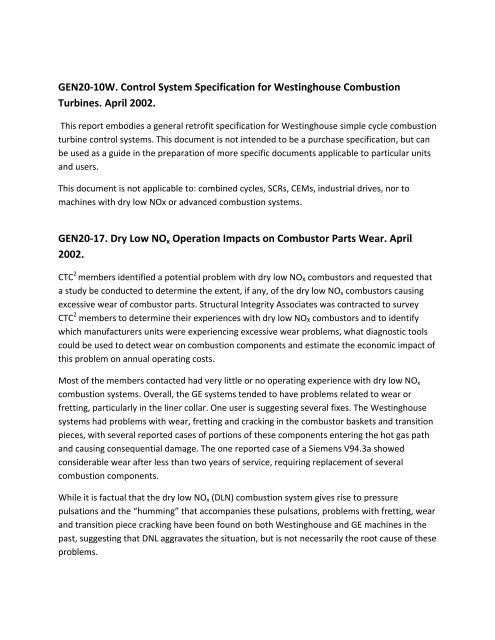GE94-02: Repair Flow Testing and Calibration Procedures for ...
GE94-02: Repair Flow Testing and Calibration Procedures for ...
GE94-02: Repair Flow Testing and Calibration Procedures for ...
You also want an ePaper? Increase the reach of your titles
YUMPU automatically turns print PDFs into web optimized ePapers that Google loves.
GEN20‐10W. Control System Specification <strong>for</strong> Westinghouse Combustion<br />
Turbines. April 20<strong>02</strong>.<br />
This report embodies a general retrofit specification <strong>for</strong> Westinghouse simple cycle combustion<br />
turbine control systems. This document is not intended to be a purchase specification, but can<br />
be used as a guide in the preparation of more specific documents applicable to particular units<br />
<strong>and</strong> users.<br />
This document is not applicable to: combined cycles, SCRs, CEMs, industrial drives, nor to<br />
machines with dry low NOx or advanced combustion systems.<br />
GEN20‐17. Dry Low NOx Operation Impacts on Combustor Parts Wear. April<br />
20<strong>02</strong>.<br />
CTC 2 members identified a potential problem with dry low NOX combustors <strong>and</strong> requested that<br />
a study be conducted to determine the extent, if any, of the dry low NOx combustors causing<br />
excessive wear of combustor parts. Structural Integrity Associates was contracted to survey<br />
CTC 2 members to determine their experiences with dry low NOX combustors <strong>and</strong> to identify<br />
which manufacturers units were experiencing excessive wear problems, what diagnostic tools<br />
could be used to detect wear on combustion components <strong>and</strong> estimate the economic impact of<br />
this problem on annual operating costs.<br />
Most of the members contacted had very little or no operating experience with dry low NOx<br />
combustion systems. Overall, the GE systems tended to have problems related to wear or<br />
fretting, particularly in the liner collar. One user is suggesting several fixes. The Westinghouse<br />
systems had problems with wear, fretting <strong>and</strong> cracking in the combustor baskets <strong>and</strong> transition<br />
pieces, with several reported cases of portions of these components entering the hot gas path<br />
<strong>and</strong> causing consequential damage. The one reported case of a Siemens V94.3a showed<br />
considerable wear after less than two years of service, requiring replacement of several<br />
combustion components.<br />
While it is factual that the dry low NOx (DLN) combustion system gives rise to pressure<br />
pulsations <strong>and</strong> the “humming” that accompanies these pulsations, problems with fretting, wear<br />
<strong>and</strong> transition piece cracking have been found on both Westinghouse <strong>and</strong> GE machines in the<br />
past, suggesting that DNL aggravates the situation, but is not necessarily the root cause of these<br />
problems.


